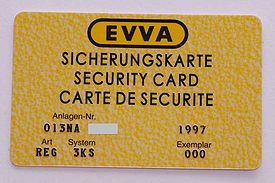Security card: Difference between revisions
mNo edit summary |
m (fab 200) |
||
| (5 intermediate revisions by 3 users not shown) | |||
| Line 3: | Line 3: | ||
[[File:EVVA_3KS_keycard.jpg|275px|thumb|right|text-top|An indirect-code security card from the [[EVVA 3KS]] lock.]] | [[File:EVVA_3KS_keycard.jpg|275px|thumb|right|text-top|An indirect-code security card from the [[EVVA 3KS]] lock.]] | ||
A '''security card''' (or '''keycard''', '''key security card''') is an object that is required to duplicate or create a given [[key]]. The purpose of security cards is to help prevent unauthorized duplication of keys for a given keying system. Many [[high security locks]] require a security card be presented to a [[locksmith]] before a key can be created or duplicated. This holds true even after patent protection of a given key blank has expired. | A '''security card''' (or '''keycard''', '''key security card''') is an object that is required to duplicate or create a given [[key]]. The purpose of security cards is to help prevent unauthorized duplication of keys for a given keying system. Many [[high security locks]] require a security card be presented to a [[locksmith]] before a key can be created or duplicated. This holds true even after patent protection of a given key blank has expired. Modern key duplication machines for high security locks will go as far as requiring the card be swiped into the machine to determine what key bitting should be cut. | ||
Security cards are obtained when the lock is purchased and used whenever additional keys are required. The cards themselves resemble credit cards, though not all contain magnetic strips. They contain the direct or indirect bitting code of the lock, the keyway profile, master keying data, and other important information on the face of the card. Many cards try to avoid this by embedding the information in the card itself, usually with a magnetic strip. More advanced cards may store auditing information (either locally or on a remote system) each time the card is used to duplicate or create a working key for the lock. | Security cards are obtained when the lock is purchased and used whenever additional keys are required. The cards themselves resemble credit cards, though not all contain magnetic strips. They contain the direct or indirect bitting code of the lock, the keyway profile, master keying data, and other important information on the face of the card. Many cards try to avoid this by embedding the information in the card itself, usually with a magnetic strip. More advanced cards may store auditing information (either locally or on a remote system) each time the card is used to duplicate or create a working key for the lock. | ||
| Line 14: | Line 14: | ||
== Gallery == | == Gallery == | ||
<div align="center"><gallery> | <div align="center"><gallery> | ||
File:Ikon_TK5_RKS_keycard.jpg|Security card for the [[IKON TK5]]. | |||
File:security-card-Angal.jpg | Security card from [[Angal]]. | |||
File:security-card-DeGuard.jpg | Security card for the [[DeGuard Dimple Lock]]. | |||
File:security-card-MTL-Jr.jpg | Security card for the [[Mul-T-Lock Junior]]. | |||
File:security-card-Yardeni.jpg | Security card for the [[Yardeni 6]]. | |||
File:FAB200_security_card_least.png | Security card for [[FAB 200]]. | |||
File:FAB4xxxx_card_least.png | Security card for [[FAB_3***/4**** |FAB 4****]]. | |||
File:FAB3xxx_card_least.png | Security card for [[FAB_3***/4**** |FAB 3***]]. | |||
File:Nemef_NF3_card_least.png | Security card for the [[Nemef NF3]]. | |||
</gallery></div> | </gallery></div> | ||
| Line 25: | Line 32: | ||
* [[High security locks]] | * [[High security locks]] | ||
[[Category:Keys]] | [[Category:Keys]][[Category:High security locks]] | ||
Latest revision as of 13:11, 21 November 2022
Security Card

A security card (or keycard, key security card) is an object that is required to duplicate or create a given key. The purpose of security cards is to help prevent unauthorized duplication of keys for a given keying system. Many high security locks require a security card be presented to a locksmith before a key can be created or duplicated. This holds true even after patent protection of a given key blank has expired. Modern key duplication machines for high security locks will go as far as requiring the card be swiped into the machine to determine what key bitting should be cut.
Security cards are obtained when the lock is purchased and used whenever additional keys are required. The cards themselves resemble credit cards, though not all contain magnetic strips. They contain the direct or indirect bitting code of the lock, the keyway profile, master keying data, and other important information on the face of the card. Many cards try to avoid this by embedding the information in the card itself, usually with a magnetic strip. More advanced cards may store auditing information (either locally or on a remote system) each time the card is used to duplicate or create a working key for the lock.
Security considerations
Because they contain as much, and sometimes more, sensitive information as keys, security cards are subject to all of the same security precautions. Cards with direct codes can be visually decoded, and those that use magnetic strips are subject to reading and duplication with the proper tools. At the same time, an unscrupulous locksmith can duplicate keys without proper authorization.
Gallery
Security card for the IKON TK5.
Security card from Angal.
Security card for the DeGuard Dimple Lock.
Security card for the Mul-T-Lock Junior.
Security card for the Yardeni 6.
Security card for FAB 200.
Security card for FAB 4****.
Security card for FAB 3***.
Security card for the Nemef NF3.








